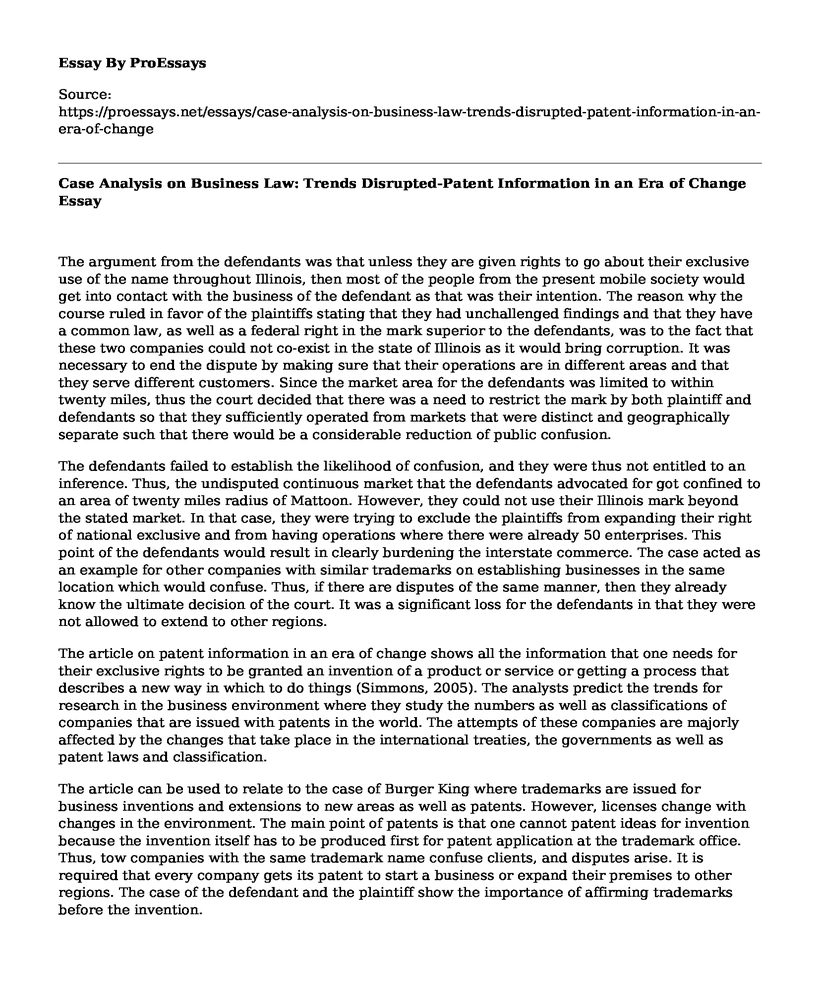The argument from the defendants was that unless they are given rights to go about their exclusive use of the name throughout Illinois, then most of the people from the present mobile society would get into contact with the business of the defendant as that was their intention. The reason why the course ruled in favor of the plaintiffs stating that they had unchallenged findings and that they have a common law, as well as a federal right in the mark superior to the defendants, was to the fact that these two companies could not co-exist in the state of Illinois as it would bring corruption. It was necessary to end the dispute by making sure that their operations are in different areas and that they serve different customers. Since the market area for the defendants was limited to within twenty miles, thus the court decided that there was a need to restrict the mark by both plaintiff and defendants so that they sufficiently operated from markets that were distinct and geographically separate such that there would be a considerable reduction of public confusion.
The defendants failed to establish the likelihood of confusion, and they were thus not entitled to an inference. Thus, the undisputed continuous market that the defendants advocated for got confined to an area of twenty miles radius of Mattoon. However, they could not use their Illinois mark beyond the stated market. In that case, they were trying to exclude the plaintiffs from expanding their right of national exclusive and from having operations where there were already 50 enterprises. This point of the defendants would result in clearly burdening the interstate commerce. The case acted as an example for other companies with similar trademarks on establishing businesses in the same location which would confuse. Thus, if there are disputes of the same manner, then they already know the ultimate decision of the court. It was a significant loss for the defendants in that they were not allowed to extend to other regions.
The article on patent information in an era of change shows all the information that one needs for their exclusive rights to be granted an invention of a product or service or getting a process that describes a new way in which to do things (Simmons, 2005). The analysts predict the trends for research in the business environment where they study the numbers as well as classifications of companies that are issued with patents in the world. The attempts of these companies are majorly affected by the changes that take place in the international treaties, the governments as well as patent laws and classification.
The article can be used to relate to the case of Burger King where trademarks are issued for business inventions and extensions to new areas as well as patents. However, licenses change with changes in the environment. The main point of patents is that one cannot patent ideas for invention because the invention itself has to be produced first for patent application at the trademark office. Thus, tow companies with the same trademark name confuse clients, and disputes arise. It is required that every company gets its patent to start a business or expand their premises to other regions. The case of the defendant and the plaintiff show the importance of affirming trademarks before the invention.
References
Simmons, E. S. (2005). Trends disrupted-patent information in an era of change. World Patent Information, 27(4), 292-301.
Cite this page
Case Analysis on Business Law: Trends Disrupted-Patent Information in an Era of Change. (2022, Aug 23). Retrieved from https://proessays.net/essays/case-analysis-on-business-law-trends-disrupted-patent-information-in-an-era-of-change
If you are the original author of this essay and no longer wish to have it published on the ProEssays website, please click below to request its removal:
- Hotel Liability Essay
- Treaty on the Functioning of the European Union - Research Paper
- Recruitment and Retention: Recruitment and Retention in the Hospitality Industry Strategies
- Business Law Case-Analysis Paper Example
- Essay on Revolutionizing Business: Technology Advances Reshaping the Work Environment
- Free Essay Sample on Ethical Compliance: Benefits for Companies and Society
- Ethics Education: Challenges of Being Honest in Business - Essay Sample







